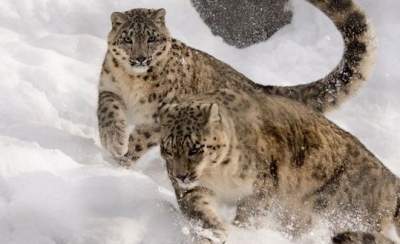Glasgow (IANS) Central Asia has joined hands at the 26th meeting of the Conference of Parties (COP26) to the UN Framework Convention on Climate Change (UNFCCC) for conservation of the snow leopard.
Now some smaller, more vulnerable countries are coming together to join forces to preserve their natural treasures and livelihoods of the local communities.
The high mountains of Asia are also known as the athird pole’ of the earth. Home to 14 of the highest peaks in the world, the ‘third pole’ is spread across the Himalayas, Hindu Kush, Pamir, Tien-Shan and Altai mountains, as well as the Tibetan plateau.
It is one of the most vulnerable regions of the planet to climate change where warming is occurring twice as fast as the rest of the Northern Hemisphere.
The snow leopard serves as an indicator of the health of the mountain ecosystems in terms of climate change and biodiversity. Its presence symbolizes ecosystem services such as fresh water and carbon sequestration that benefit human populations of billions living downstream.
Experts say the conservation of snow leopards is synonymous to conservation of biological and cultural diversity and securing livelihoods of the ‘third pole’.
The mountains represented by the snow leopard habitat offer economic opportunity, and open avenues for influx of green investments for sustainable livelihoods of the local communities sharing their space with wildlife across the pastures and agricultural lands in the region, Koustubh Sharma, International Coordinator for the Global Snow Leopard and Ecosystem Protection Program, told IANS here.
The close relationship between the snow leopard conservation and the well-being of the local communities makes snow leopard conservation equivalent to climate adaptation, he said.
The snow leopard moves between international borders seamlessly as long as they are not fenced, making it an ambassador for trans-boundary cooperation in the mountainous regions.
Conserving the snow leopard and its unique habitat requires coordination beyond international borders, and its importance is highlighted in the Bishkek Declaration 2013 and 2017 that was endorsed by the governments of all snow leopard range countries.
The UN resolution titled aNature knows no borders: Transboundary cooperation is key factor in conservation and sustainable using of biodiversity’, proposed by the Kyrgyz Republic and endorsed unanimously at the 75th UN General Assembly is a testimony to the greater global acknowledgement for transboundary action for biodiversity conservation and climate adaptation.
A memorandum of understanding for trans-boundary cooperation was signed between the Central Asian snow leopard range countries for cooperation in research and monitoring, combating illegal wildlife trade, and community-based conservation in the West Tien Shan and Pamir-Alay.
The signing was part of a ministerial event hosted by the Benelux pavilion and the Luxembourg government that focused on the innovative approach that UNEP’s Vanishing Treasures project is taking to build resilience of mountain flagship species, their habitat and local communities to climate change.
Bahodur Sheralizoda, Chairman of the Committee for Environmental Protection under the government of Tajikistan, Beksultan Ibraimov, Deputy Minister of Natural Resources, Environment and Technical Supervision for Kyrgyz Republic, and Jusipbek Kazbekov, Deputy Chairman of the State committee for Ecology and environment protection of Uzbekistan, signed the pact on behalf of their respective countries’ governments.
The signing was preceded by a session on joining forces for snow leopard conservation in the context of climate adaptation, hosted at the Central Asia pavilion of COP26.
Snow leopards face a multitude of threats, including retaliatory killing, illegal wildlife trade, poaching and excess hunting of its wild prey, poorly planned infrastructure, and mining.
Climate change is hailed as the mother of all threats for how it interacts with and amplifies each of the existing threats biodiversity and local communities face.
A recent policy brief released by the Global Snow Leopard and Ecosystem Protection Program and the Snow Leopard Trust highlights reports that the snow leopard habitat is far more vulnerable to infectious diseases than earlier believed.


